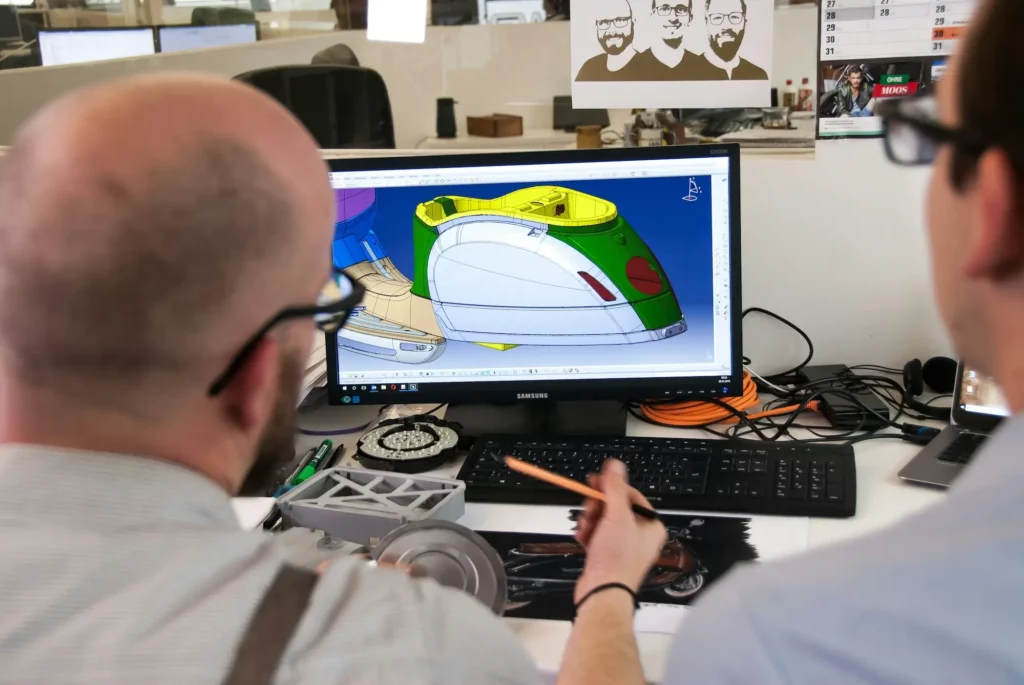Working with CAD files can get messy fast. You might open the wrong format, lose track of changes, or waste time waiting for files to load.
File types don’t always play well together, and using the wrong one can slow down design reviews or confuse people during engineering standups. It’s even harder when your team uses different tools or works in different time zones.
This article breaks down 14 common CAD file types and shows when to use each one.

CAD File Formats: What They Store and How They Work
CAD file formats are digital containers used in computer-aided design. They store not just drawings and models, but also the data needed to open, view, or edit them in different design tools.
Each file type shows how the design is saved and which software can read it. Designers often switch between formats depending on what they need.
Here’s what CAD files usually include:
- Geometry representation: Stores shapes using either meshes or B-Rep. Meshes use surface triangles. B-Rep uses exact curves, edges, and surfaces.
- Topology: Found in B-Rep files. Defines the model type: solid, wireframe, or surface.
- Product structure: Organizes the design. Includes assemblies, components, and how parts fit together.
- Meta-data: Adds extra details like layer names, part names, attributes, and product manufacturing info (PMI).
- Visual properties: Includes color, texture, materials, and lighting for realistic display.
Collaborate on STEP, IGES, SolidWorks, and more. All in one place with CADchat.
Categories of CAD File Formats
CAD file formats fall into several groups based on how they’re used, shared, or supported. Some are preferred formats tied to specific software, while others use widespread supported formats for better sharing. You’ll also find formats meant only for viewing, not editing.
These file formats are usually grouped into two categories:
Based on File Nature: Native vs Neutral
CAD files are often categorized by their file nature to help users choose the right format for their needs. This grouping makes it easier to manage files, avoid compatibility issues, and pick the right file type for product design, review, or manufacturing.
CAD files can be divided into two types based on nature:
- Native formats: Tied to particular CAD software. They store full design data such as model history, features, and settings. Examples of mechanical CAD software include SolidWorks (.SLDPRT), AutoCAD (.DWG), and CATIA (.CATPart). These are best when working within the same software.
- Neutral formats: Meant for compatibility. Native files allow users to open and view models in different systems without needing the original software. Popular neutral CAD formats include STEP (.STEP), IGES (.IGS), and PDF, which can be viewed in tools like Adobe Reader. These formats are often used in mechanical CAD and model-based definition workflows.
Some neutral formats are based on modeling kernels, which are the core engines behind CAD systems for engineers and product teams. Others are simplified for viewing or sharing only.
Based on Dimensionality: 2D vs 3D
CAD file formats are often grouped by dimensionality because 2D and 3D files serve different goals.
- 2D files: Focus on flat drawings, like floor plans or technical sketches. These are often used for simple layouts or quick edits. They tend to be lightweight and work well across different systems.
- 3D files: Handle more complex data, including surface geometry, material properties, and visual representation. These formats are common in mechanical CAD and detailed product designs. Many 3D files also support model-based definition, which includes full manufacturing data.
Some formats are preferred formats for 2D, while others are built for 3D. A few widely supported formats work for both. Choosing the wrong one can cause various CAD problems, such as slow performance, wrong orientation, or loss of data.
To avoid this, designers often use the following formats that match the tool and project type. The right pick depends on whether the focus is drawing or modeling.
14 Main CAD File Formats And Their Typical Use Cases
CAD files come in many types, each with a specific use. This list covers 14 common formats. You’ll learn what each one does, where it’s used, and when it’s the preferred format.
1. STEP (.step/.stp)
Best for: Sharing solid 3D models between different CAD programs without losing design accuracy.
STEP format is one of the most widely used file types in 3D CAD. It’s a neutral format, which means it works across many different 3D CAD programs.
Engineers and designers like it because it keeps the exact shape, size, and structure of 3D parts and assemblies. You can use it to share models between teams, even if they’re using different software.
STEP keeps solid model data. This makes it more useful when you need to keep design details. It’s also better than older formats like IGES because it supports full 3D assemblies, not just single parts or wireframes.
Many industries use STEP for manufacturing, especially when working with suppliers who use different tools. It’s part of an international standard (ISO 10303), so it’s built for long-term use and wide support.
2. IGES (.igs/.iges)
Best for: Working with older CAD systems or sharing wireframe and surface models.
IGES stands for Initial Graphics Exchange Specification. It’s one of the first neutral file formats made for 3D CAD. IGES files can store wireframes, surfaces, and some solid geometry. This makes them useful for sharing designs between different software, especially older systems.
While IGES is not as modern as STEP, it’s still used in many industries where legacy tools are common. Some CAD programs rely on it to handle older projects or to work with surface-based models.
However, IGES does not always carry full 3D assembly or parametric data, so it’s better suited for simpler shapes or when exact solids are not needed.
3. SLDPRT (.sldprt)
Best for: Creating and editing detailed part models within SolidWorks.
SLDPRT is the file format used for part models in SolidWorks. It saves everything about a 3D part, including sketches, features, dimensions, and design history. Because of this, it gives users full control to edit and rebuild the part inside SolidWorks.
These files are only fully supported within SolidWorks. If you need to use the model in other CAD tools, you’ll often have to convert it to a more neutral format like STEP or find a design feedback tool that can read this file type.
Still, when staying in the SolidWorks environment, SLDPRT files give you everything you need for precise modeling and design updates.
4. Parasolid (.x_t/.x_b)
Best for: Sharing exact 3D geometry between CAD systems that use the Parasolid engine.
Parasolid is a geometry file format used by many CAD programs. It was developed by Siemens and is used as the modeling engine behind tools like SolidWorks, Siemens NX, and others.
There are two types: .x_t is the text version, and .x_b is the binary version. Both store the same data, just in different formats.
Parasolid files hold detailed solid and surface geometry. They don’t carry sketches or design history, but they are great for moving clean, accurate 3D shapes between systems that use the same modeling engine.
Many CAD programs can import or export Parasolid files, making them a common choice for transferring models while keeping precise geometry.
Review designs from different CAD tools together in one workspace. Start with CADchat.
5. IPT (.ipt)
Best for: Designing and editing parts inside Autodesk Inventor.
IPT is the file format used for part models in Autodesk Inventor. It stores full parametric data, including sketches, features, constraints, and design history. This makes it easy to go back and change any part of the model within Inventor.
IPT files are made to work inside the Autodesk Inventor environment. They are not widely supported by other CAD programs, so if you need to share the model outside Inventor, you’ll likely need to convert it to a neutral format like STEP or IGES.
These files are used in product design, mechanical engineering, and manufacturing where Inventor is part of the workflow.
6. CATPART (.catpart)
Best for: Building and editing 3D parts in CATIA, especially for aerospace and automotive projects.
CATPART is the file format used for part models in CATIA, a CAD software developed by Dassault Systèmes. These files hold all the details of a 3D part, including features, parameters, and design history.
They are made to work inside the CATIA system, which is often used in complex fields like aerospace and automotive design.
CATPART files are not easy to open in other CAD programs. If you need to share the model outside of CATIA, you’ll usually need to convert it to a neutral format like STEP. Still, within CATIA, these files give full access to the part’s structure and details.
7. SAT (.sat)
Best for: Transferring precise 3D geometry between systems that use the ACIS modeling engine.
SAT is the file format used by the ACIS modeling engine, which powers many CAD and engineering tools.
It stores solid and surface geometry with high accuracy. SAT files are often used to move 3D models between programs that support the ACIS kernel.
These files do not hold parametric features or design history. They focus on exact shapes and structures, which makes them good for sharing finished geometry.
Many CAD, CAM, and CAE tools can read SAT files, especially those built on the same engine.
8. STL (.stl)
Best for: Preparing and exporting 3D models for printing or quick visual prototypes.
STL files are one of the most common formats used for 3D printing. They store the shape of a 3D object using a mesh of small triangles. This mesh shows the surface of the model, but it doesn’t include any design history, measurements, or solid model data.
Because STL files are simple and lightweight, they’re easy to share and fast to load during design review meetings. Most 3D printers and slicer software support STL files, which makes them a popular choice for prototyping.
However, they are not ideal for editing or detailed design work since they don’t carry features or parametric data.
9. X3D
Best for: Web-based 3D graphics, virtual reality, and interactive model viewing.
X3D is a file format used to describe 3D models, scenes, and animations. It’s the modern version of the older VRML format, which stands for Virtual Reality Modeling Language.
Like VRML files, X3D files are made for web-based 3D graphics, interactive scenes, and virtual reality.
X3D supports shapes, colors, lighting, textures, and even animations. It’s written in XML, which makes it easier to read and update. You can use X3D files in online 3D viewers, games, simulations, and training tools.
While not used much in CAD for design or manufacturing, it’s helpful for sharing 3D models online or in interactive apps.
10. DWG (.dwg)
Best for: Creating and editing detailed 2D drawings in AutoCAD.
DWG is the native file format for AutoCAD. It’s one of the most widely used formats in the design world, especially for 2D drawings.
DWG files store lines, shapes, layers, dimensions, and sometimes even 3D data. They’re commonly used in architecture, engineering, and construction.
Because DWG files are compact and detailed, they’re great for creating and editing technical drawings. Many CAD programs can open DWG files, but they work best inside AutoCAD or other Autodesk tools.
Manage CAD feedback in one place, even with multiple formats. Explore CADchat today!
11. DXF (.dxf)
Best for: Sharing 2D CAD drawings between different software and preparing files for CNC or laser cutting.
DXF stands for Drawing Exchange Format. It was created by Autodesk to make it easier to share CAD drawings between different programs.
DXF files store 2D data like lines, curves, and text, and can also include some 3D details, though they’re mainly used for 2D work.
Unlike DWG, which is a binary format, DXF is text-based. This makes it easier to read and use in other software, including CNC machines and laser cutters. It’s a popular choice when you need to send 2D designs to someone using different tools.
12. DGN (.dgn)
Best for: Civil engineering and infrastructure projects designed in MicroStation.
DGN is the native file format for MicroStation, a CAD program used mainly in civil engineering and infrastructure projects.
These files store 2D and 3D drawings, including geometry, text, and design data. DGN files are often used by government agencies, transportation departments, and construction teams.
While not as common as DWG or DXF, DGN files are important in large-scale projects where MicroStation is the main design tool. Some CAD programs can open DGN files, but they work best within the Bentley software ecosystem.
13. JT
Best for: Viewing and sharing 3D models in a compact format, especially for review and collaboration.
JT files are lightweight 3D files used for viewing and sharing models without needing full design data. They are often used in the automotive and aerospace industries, where teams need to look at models but don’t need to edit them.
JT files store shapes, materials, and sometimes product structure. They are smaller than most 3D CAD files, which makes them easier to load and send.
You can use JT files for reviewing parts, checking assemblies, or sharing models with people who don’t use CAD software.
14. 3D PDF
Best for: Sharing interactive 3D models with people who don’t use CAD tools.
3D PDF is a type of PDF file that can hold and display 3D models. You can open it with Adobe Reader and view the model from any angle, zoom in, or turn parts on and off. This makes it easy to share 3D designs with people who don’t have CAD software.
3D PDFs keep the file size small and are easy to send by email or upload to a website. They’re often used for presentations, client reviews, or team discussions. While you can’t edit the design in a 3D PDF, it’s a simple way to show what a model looks like.
CAD Collaboration Software Built for CAD Interoperability

No matter what CAD software your team uses, CADchat makes it easy to collaborate. It supports all major CAD file types, so you don’t have to worry about CAD interoperability issues. Upload native files, leave feedback, and make design decisions, all in one place.
Whether your team works in SolidWorks, AutoCAD, Fusion 360, or any other tool, CADchat keeps everyone on the same page. You can review models, track changes, and stay aligned without juggling emails or converting files.
FAQs About the Types of CAD Files
What are the different types of CAD files?
There are many types of CAD files used across different CAD software. Some are native CAD files tied to specific CAD systems, like .ipt for Autodesk Inventor.
Others are neutral CAD file formats like STEP, IGES, STL, JT, and 3D PDF. These neutral CAD formats help with data exchange between different CAD software without needing the original program.
What are the four types of CAD?
The four main types of CAD are 2D drafting, 3D modeling, 3D parametric modeling, and 3D surface modeling.
These types support different CAD file format extensions and geometric modeling kernel styles depending on the CAD design needed.
Some formats focus on technical drawings, while others work better for 3d printing or rapid prototyping. Teams export files to different formats based on what they need for their current project or the specific CAD software they’re using.
Is DXF a CAD file?
Yes, DXF is a CAD file. It stands for Drawing Exchange Format and is one of the most common file types used for sharing 2D drawings between different CAD systems.
DXF files are human-readable, work with many CAD programs, and are a popular choice for exporting or viewing CAD files without needing the original CAD software.
What is the most universal CAD file type?
The STEP file is the most universal CAD file type today. It’s a neutral file format that works well with most CAD software, supports solid models, and keeps the assembly structure intact.
STEP files are widely supported, making them a great CAD export option when working with other formats or switching between systems.


